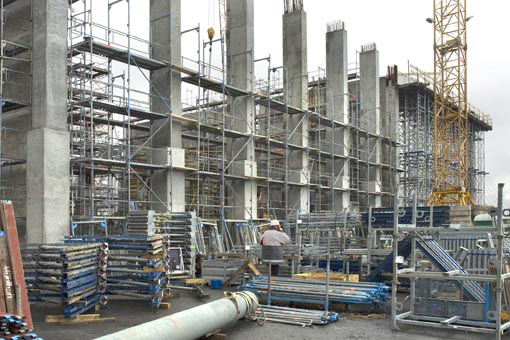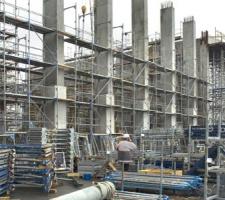
Steinbeis Papier Glückstadt is investing in a state-of-the-art industrial power plant in Germany and using some hi-tech ready mixed concrete to meet the demands of the project
Energy supply is a challenging issue for modern industry and one paper manufacturer is building its own energy generation plant with combined heat and power (CHP) in a bid to become independent. But taking this step at the site in Glückstadt, Germany will involve a high demand on the ready mixed concrete capabilities of
The main contractor for the plant is Kähler Hochbau, which is working with Friedrich Peters Bau and Doose Bau for the scheme. It is with this partnership that Cemex has been working to supply 6,500m3 of ready-mix concrete for the boiler house, the ash silo, the flue gas desulphurisation and the fuel storage.
The cast in-situ concrete parts comprise foundation plates, pillars, walls, concrete beams and the stair towers. The new power plant is built on around 700 concrete driven piles made of around 3,000m3 of ready-mix concrete by Hamburg-based GKT Spezialtiefbau.
The bulk of concrete used on the project was produced by Cemex's ready-mixed plant in Elmshorn 20 km away. At peak times they were supported by plants in Hohenlockstedt and Gudendorf. Up to 15 concrete mixer trucks supplied the large-scale construction site with concrete, and Cemex-Betonförderung used GME 42 and GME 36 concrete pumps to place material on site.
Five main recipes were used for strength classes between C 25/30 and C 45/55. "Considering the technological part of the concrete production, this project is interesting with regard to low-shrinking concrete and concrete for slip forming," explained Cemex Deutschland concrete specialist Friedrich Bahrs.
Bahrs was charged with the task of determining specifications and exposition classes, together with the company's leading concrete technologist Gesche Mentzer, and the customer.
"The concrete of the foundation bases was cast in sections of 400 to 700m3," said Bahrs. "A low-shrinkage concrete of strength class C35/45 and of consistency class F3 was used to achieve these pours."
For this particular industrial application, Cemex selected chippings with 8, 16 and 32mm maximum grain sizes. But according to Bahrs, the after-treatment was complex. "Here at the banks of the Lower Elbe, just 50 km from the North Sea, it is rarely calm, and premature cooling and drying of the massive concrete components had to be avoided," he said. "For this reason, the staff of Kähler Hochbau GmbH wrapped the freshly cast concrete surfaces in foil or flooded them with water." The steel construction company erected the 43m high boiler house where the steam to drive the turbine will be generated. The remaining steam will be conducted to the paper machine to dry the paper. This combined heat and power from the new boiler installation is expected to deliver an efficiency of 87 % compared to the conventional power plant efficiency of 46 %. Adjacent to the boiler house is a slipformed stair tower which in an emergency will serve as an escape route for plant workers. Cemex's concrete specialists agreed to use a
rapid-hardening, high-strength concrete C 35/45 for this construction. After just four hours the concrete of the lower section had hardened and was firm enough to carry the sheathing for the next section. The concreting process took just seven days.
Other construction work on the project is progressing well and the power plant will start to operate at the latest at the beginning of 2010.
Once operational, Steinbeis Papier Glückstadt will benefit from the most advanced power plant technology available at present. Thanks to a circulating fluidised bed, the emissions of the power plant will fall below the strict statutory provisions and waste from the paper production, mineral coal and refuse derived fuels (RDF) will fuel the power plant. Due to their high biogenic content, the latter allow for a climate-friendly energy generation with CO2 emissions reduced by up to 50%.















